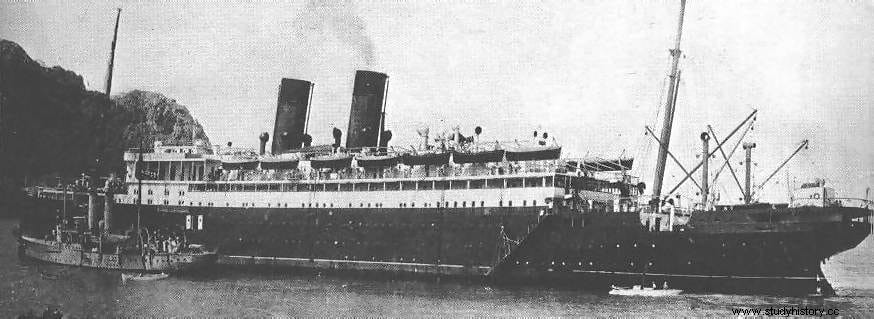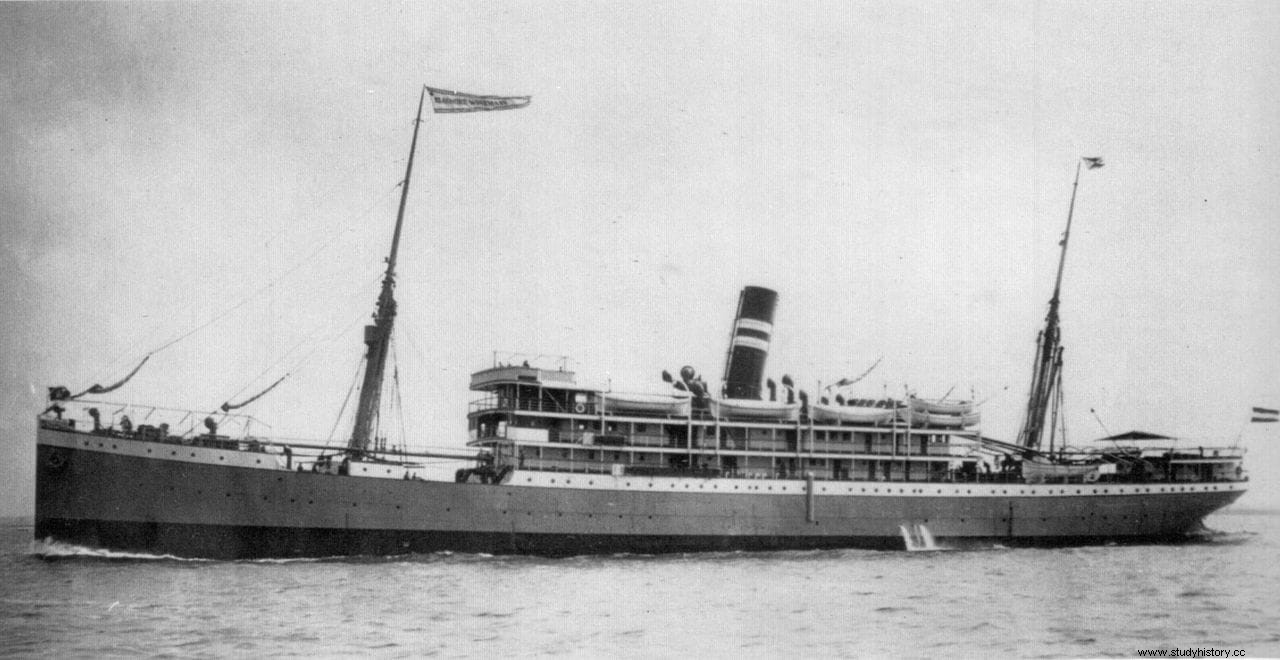In times of war there is no place for pleasure trips, which is why the belligerent countries often convert their pleasure and merchant ships into armed or transport ships, if not into floating hospitals; This is what happened with the ocean liners during the First World War, as we have already seen here in several articles (the one dedicated to the RMS Asturias , for instance). Today we return to the subject with the story of the SMS Cap Trafalgar , a large passenger ship that the Kaiserliche Marine she requisitioned and adapted as an auxiliary cruiser and ironically ended up being sunk by a British counterpart whose appearance she imitated.
The SMS Cap Trafalgar , whose name was an obvious tribute to the Spanish geographical accident, was born in the AG Vulcan shipyard, a shipyard located in the German city of Stettin (currently the Polish Szczezin) that had been working in shipbuilding since its foundation in 1851 and specialized in transatlantic the Kaiser class, of which he made four units (one of them sunk in the First World War and the other three seized by the US in 1917). The Cap Trafalgar it wasn't part of it, since she was a little smaller and was thrown out a couple of years later.
Specifically in July 1913, entering service on the route that the owner shipping company, the Hamburg Südamerikanische Dampfschifffahrts-Gesellschaft (today Hamburg Süd) operated between Germany and the Río de la Plata, making stops at ports in Brazil, Uruguay and Argentina. In fact, that was its maiden voyage in the spring of 1914, being one of the most luxurious transports that crossed the Atlantic:swimming pool, greenhouse, noble wood in the furniture of the cabins, golden moldings in common areas... A world apart for its privileged passengers (it could carry up to 1,600) who would hardly have time to enjoy it.

And it is that the outbreak of the global war in the summer of that same year forced it to be requisitioned to incorporate it into the aforementioned Imperial Navy. Thus, at 187 meters long by 22 meters wide, 18,710 tons and twin triple expansion engines that provided a power of 15,000 horsepower and a speed of 17 knots, two SK L 10.5 cannons were added. cm. and six 37mm Pounder machine guns. from the gunboat SMS Eber , who would stay in Brazil until 1917, when that country entered the war in favor of the allies, she was sunk by her own men in Salvador de Bahía.
This transformation took place on the Brazilian island of Trinidad, where the Kaiserliche Marine he had established a supply base. There the ship received the code name of Hilfskreuzer B (that is, Auxiliary Cruiser B) and the crew of the aforementioned Eber was assigned to it. under the command of Lieutenant Commander Julius Wirth. Properly equipped with ammunition and provisions, she went out to sea with the mission of attacking British merchantmen, although she had to return on September 13 to take advantage of the arrival of several colliers (bulk coal ships that allowed refuelingin situ ) and thus increase the coal that she had previously uploaded in Montevideo -where she had moved from Buenos Aires upon receiving the news that her country was at war-.
In parallel, the Royal Navy had done almost exactly the same operation with the RMS Carmania , from the famous Cunard company. She was a twin of the RMS Caronia , with which she formed the largest pair of ships in that shipping company's fleet:198 meters long, 22 meters wide and 19,524 tons, reaching 18 knots. Built in the Scottish shipyards of Clydebank by John Brown &Company (the same company that made other famous ocean liners such as the Lusitania , the Queen Mary or the Queen Elizabeth eth, in addition to the cruisers HMS Repulse and HMS Hood ), the Carmania was launched in 1904 and made her maiden voyage a year later between Liverpool and New York, a route she would continue to operate until 1910.

That year she suffered a fire that forced it to be temporarily removed, although she later returned to the ocean and, coincidentally, in 1913 she even participated in the rescue of the passengers of the SS Voltunio , also prey to flames. At the outbreak of war she was converted into an armed merchantman, equipping her with eight 120mm Mark V guns. and putting to the control of her the captain Noel Grant. The mission entrusted to him was to sail to Bermuda and then head south to intercept and sink merchantmen and coalboats enemies that took advantage of the aforementioned base on the island of Trinidad. So on the morning of September 14, she arrived at that place to find herself at Cap Trafalgar coaling with two colliers .
The surprise must have been double because the Teutonic ship had an appearance very similar to that of the British; apparently deliberately to be able to get closer to her prey more easily. In fact, she even had the third of her chimneys removed because it was false and had been placed only for aesthetic reasons, so that she now passed at first sight for the Carmania . Curiously and erroneously, some sources say the opposite:that it was the British ship that adopted the other's appearance, which is impossible because, as we have seen, she made her alterations before and hunted her down.
Both contestants headed out into the open water, given the need for room to maneuver that her enormous size demanded. The cannons of the Carmania they were the first to open fire but did so prematurely, so they fell short; that gave a slight advantage to Cap Trafalgar , which she fired at the proper distance and hit her opponent. However, these were ships too large for pieces of the caliber they had, so they spent two hours exchanging blows without being decisive.

However, the British came out of that duel worse off, receiving up to 79 hits that destroyed her bridge and opened a leak in her hull. Nor was the German intact and both were engulfed in flames, since being adapted ocean liners they lacked adequate extinguishing systems, as well as a modern ammunition method; this forced them to carry out these tasks manually, as if it were a naval combat from another era and, in effect, they brought their sides closer to a few hundred meters to continue the fight with the deck machine guns.
So, the men of Carmania They got a monumental surprise. They were desperate, trying in vain to control the fire on board and thinking that they had lost the battle, when suddenly they saw how the Germans lowered the boats and abandoned their ship. Shortly after, she began to list to port and sank in a few minutes; it turned out that she had inadvertently hit him below her waterline, irrevocably flooding several compartments with water.
The colliers , who awaited the outcome of the meeting from a distance, did not dare to approach to rescue the shipwrecked, for fear of being shot and 279 sailors were left in the water; It is not known exactly how many died, calculating between 15 and fifty, including the captain. The Carmania , on the other hand, only recorded 9 deaths, although she had many wounded and suffered significant damage. It could have been worse because at that moment an unexpected visitor entered the scene:the SS Kronprinz Wilhelm , another German ocean liner converted into an auxiliary cruiser that came in response to calls from Cap Trafalgar.

The newcomer had an extensive record of sinking, sixteen, and was an obvious danger to a Carmania battered, inert and still on fire. But, incomprehensibly, his kapitänleutnant , Paul Thierfelder, decided not to confront him and leave the place, since the Cap Trafalgar he had already foundered and there was nothing he could do about it. Thierfelder apparently feared that it was a trap and that enemy ships were appearing in the distance. The fact is that this excess of caution saved the British, who were barely afloat and headed south in the hope of running into a friendly ship.
They were also lucky in that because the next day, in the state in which it was, about to sink, several units of the Royal Navy arrived and towed it to Pernambuco. Meanwhile, the charcoal merchant Eleonore Woermann (which was actually also an adapted passenger steamer) was finally able to rescue the German castaways and take them to Buenos Aires, from where they were transferred to Martín García, an island at the mouth of the Río de la Plata that was used as a prison, and there they spent the rest of the war.
Regarding the Carmania , she was rushed for repairs and then taken to Gibraltar for further overhaul. Thanks to her, he was able to participate in the Gallipoli campaign, being assigned since then to mere troop transport. In 1919, after the conflict, she resumed her commercial activity until she was scrapped in the thirties. Her bell is preserved aboard the HQS Wellington , a Grimsby-class sloop that saw action in both world wars and is now in a dry dock in London, as a floating museum.
